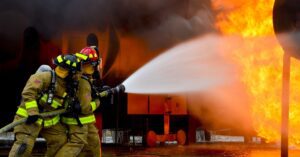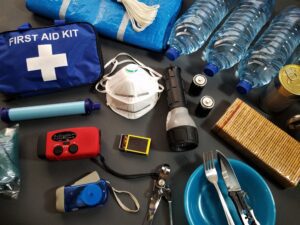10 Essential Home Safety Tips: Protecting What Matters
Your home, a sanctuary of comfort, should also be a fortress of safety. Accidents, often unforeseen, can strike at any moment. Therefore, it’s imperative to understand and implement crucial home safety measures. In this article, we’ll delve into 10 essential home safety tips, equipping you with the knowledge to safeguard your haven. We’ll explain each tip with clarity and detail, using plain language that everyone can grasp. Whether you’re a seasoned homeowner or just starting out, let’s embark on this journey to fortify your home’s security and well-being.
Creating a Fire-Safe Home
To create a fire-safe home, equip yourself with fire extinguishers. Place them strategically in areas like the kitchen and garage, where fire risks are higher. Additionally, store flammable materials away from potential heat sources, reducing the likelihood of fires.

Securing Entry Points: Doors and Windows
The security of your home starts with reinforced entry points. Install deadbolts on your doors and peepholes to see who’s at your doorstep without opening it. Don’t forget to add window locks, making it more difficult for potential intruders to gain access.
Effective Use of Smoke Detectors
Smoke detectors are your silent guardians against fire hazards. Regularly test them to ensure they’re functioning correctly. Remember, smoke detectors should be present in every bedroom and on every level of your home. Changing the batteries at least twice a year is crucial.
Kitchen Safety: Preventing Cooking Mishaps
The kitchen, a hotspot for potential accidents, demands vigilance. Never leave your cooking unattended. Keep flammable items, like dish towels, away from the stove. When handling hot pots and pans, always use oven mitts and pot holders to prevent burns.
Electrical Safety: Avoiding Overloads and Hazards
Electrical safety is paramount. Employ surge protectors to shield your electronic devices from power surges. Avoid overloading outlets, as this can lead to overheating and fires. Promptly replace any damaged cords or wires. Regular inspections of your wiring system are advisable.

Read:15-basics-of-electrical-energy-powering-our-world
Childproofing Your Home
If you have young children, childproofing is imperative. Install safety gates to restrict access to certain areas. Cover electrical outlets with protective covers to prevent accidents. Secure heavy furniture to the wall to prevent tipping incidents.
Bathroom Safety: Slips and Falls Prevention
To mitigate the risk of slips and falls in the bathroom, install grab bars in the shower and near the toilet. Non-slip mats in the bathtub provide additional stability. Adequate lighting is essential, especially during nighttime bathroom visits.

Emergency Preparedness: First Aid and Kits
Being prepared for emergencies is key. Maintain a well-stocked first aid kit that includes adhesive bandages, antiseptic wipes, tweezers, scissors, adhesive tape, and pain relievers. Familiarize yourself with basic first aid procedures, and keep a list of emergency contact numbers within easy reach. Additionally, have an emergency kit on hand, stocked with essentials such as water, non-perishable food items, flashlights, and batteries.

Carbon Monoxide Awareness
Carbon monoxide is a silent and deadly threat. Install carbon monoxide detectors near sleeping areas in your home. These detectors are crucial for the early detection of this odorless and colorless gas, potentially saving lives.

Burglar-Proofing Your Home
Enhancing your home’s security against burglaries involves outdoor lighting, particularly motion-activated lights. Reinforce entry points with security cameras and smart locks, providing an additional layer of protection. Always lock your doors and windows when leaving your home.
Conclusion: A Secure Haven
Safety isn’t just a responsibility; it’s a commitment to protecting what matters most. These 10 essential home safety tips are your armor against unforeseen accidents and incidents in your home. By implementing these measures, you’re not only fortifying your property but, more importantly, safeguarding the well-being of your loved ones.
FAQs about Home Safety
Q1: How often should I test my smoke detectors?
Testing your smoke detectors at least once a month is advisable. Additionally, change the batteries at least twice a year, typically when daylight saving time begins and ends.
Q2: What should be included in a basic first aid kit for the home?
A basic first aid kit should contain essential items such as adhesive bandages, antiseptic wipes, tweezers, scissors, adhesive tape, pain relievers, and any specific medications needed for your family members.
Q3: Are there additional steps for homes in earthquake-prone areas?
Yes, homes in earthquake-prone areas should secure heavy furniture and appliances to prevent them from toppling during a quake. Consider anchoring your home’s foundation and having an earthquake kit ready.
Q4: How can I make my home more energy-efficient while maintaining safety?
To balance safety and energy efficiency, ensure that windows and doors are properly sealed to prevent drafts. Consider upgrading to energy-efficient appliances and lighting while following safety guidelines for installation.
Q5: What are some common signs of a carbon monoxide leak in the home?
Common symptoms of carbon monoxide exposure include headaches, dizziness, nausea, confusion, and flu-like symptoms. If you suspect a carbon monoxide leak, evacuate your home immediately and call emergency services.
